Spatially Resolved Temperature Distribution in a Rare-Earth-Doped Transparent Glass-Ceramic
Abstract
:1. Introduction
2. Experimental Section
2.1. Experimental Setup
2.2. Fluorescence Microscopy System
2.3. Temperature-Sensing Material and Temperature Mapping
2.4. Numerical Simulation of the Temperature Distribution
2.5. Image Processing
3. Results and Discussion
4. Conclusions
Supplementary Materials
Author Contributions
Funding
Institutional Review Board Statement
Informed Consent Statement
Data Availability Statement
Acknowledgments
Conflicts of Interest
References
- Baczkowski, L.; Carisetti, D.; Jacquet, J.; Kendig, D.; Vouzelaud, F.; Gaquiere, C. Thermal characterization of high power AlGaN/GaN HEMTs using infra red microscopy and thermoreflectance. In Proceedings of the 20th International Workshop on Thermal Investigations of ICs and Systems, London, UK, 24–26 September 2014; pp. 1–6. [Google Scholar]
- Arenas, O.; Al Alam, É.; Aimez, V.; Jaouad, A.; Maher, H.; Ares, R.; Boone, F. Electrothermal Mapping of AlGaN/GaN HEMTs Using Microresistance Thermometer Detectors. IEEE Electron. Device Lett. 2015, 36, 111–113. [Google Scholar] [CrossRef]
- Fontanarosa, D.; Francioso, L.; De Giorgi, M.G.; Vetrano, M.R. MEMS Vaporazing Liquid Microthruster: A Comprehensive Review. Appl. Sci. 2021, 11, 8954. [Google Scholar] [CrossRef]
- Mohanty, S.K.; Chen, Y.-Y.; Yeh, P.-H.; Horng, R.-H. Thermal Management of GaN-on-Si High Electron Mobility Transistor by Copper Filled Micro-Trench Structure. Sci. Rep. 2019, 9, 19691. [Google Scholar] [CrossRef] [PubMed]
- Won, Y.; Cho, J.; Agonafer, D.; Asheghi, M.; Goodson, K.E. Fundamental Cooling Limits for High Power Density Gallium Nitride Electronics. IEEE Trans. Compon. Packag. Manuf. Technol. 2015, 5, 737–744. [Google Scholar] [CrossRef]
- Pomeroy, J.W.; Uren, M.J.; Lambert, B.; Kuball, M. Operating channel temperature in GaN HEMTs: DC versus RF accelerated life testing. Microelectron. Reliab. 2015, 55, 2505–2510. [Google Scholar] [CrossRef] [Green Version]
- Ziade, E.; Yang, J.; Brummer, G.; Nothern, D.; Moustakas, T.; Schmidt, A.J. Thickness dependent thermal conductivity of gallium nitride. Appl. Phys. Lett. 2017, 110, 31903. [Google Scholar] [CrossRef]
- Hua, Y.; Li, H.; Cao, B. Thermal Spreading Resistance in Ballistic-Diffusive Regime for GaN HEMTs. IEEE Trans. Electron. Devices 2019, 66, 3296–3301. [Google Scholar] [CrossRef]
- Geisz, J.F.; France, R.M.; Schulte, K.L.; Steiner, M.A.; Norman, A.G.; Guthrey, H.L.; Young, M.R.; Song, T.; Moriarty, T. Six-junction III–V solar cells with 47.1% conversion efficiency under 143 Suns concentration. Nat. Energy 2020, 5, 326–335. [Google Scholar] [CrossRef]
- Bouzin, M.; Marini, M.; Zeynali, A.; Borzenkov, M.; Sironi, L.; D’Alfonso, L.; Mingozzi, F.; Granucci, F.; Pallavicini, P.; Chirico, G.; et al. Photo-activated raster scanning thermal imaging at sub-diffraction resolution. Nat. Commun. 2019, 10, 1–9. [Google Scholar] [CrossRef] [Green Version]
- Chen, C.; Shen, T.; Du, Z.; Zhang, J.; Wang, J.; Marconnet, A.; Pan, L. Microscale two-dimensional (2D) temperature mapping by ratiometric fluorescence imaging under orthogonal excitations. Exp. Therm. Fluid Sci. 2018, 94, 168–171. [Google Scholar] [CrossRef]
- Zakiyyan, N.; Darr, C.M.; Chen, B.; Mathai, C.; Gangopadhyay, K.; McFarland, J.; Gangopadhyay, S.; Maschmann, M.R. Surface Plasmon Enhanced Fluorescence Temperature Mapping of Aluminum Nanoparticle Heated by Laser. Sensors 2021, 21, 1585. [Google Scholar] [CrossRef] [PubMed]
- Voulgaropoulos, V.; Aguiar, G.M.; Markides, C.N.; Bucci, M. Simultaneous laser-induced fluorescence, particle image velocimetry and infrared thermography for the investigation of the flow and heat transfer characteristics of nucleating vapour bubbles. Int. J. Heat Mass Transf. 2022, 187, 122525. [Google Scholar] [CrossRef]
- Dramićanin, M.D. Trends in luminescence thermometry. J. Appl. Phys. 2020, 128, 40902. [Google Scholar] [CrossRef]
- Fan, X.; Zhang, W.; Lü, F.; Sui, Y.; Wang, J.; Xu, Z. Research of Fluorescent Properties of a New Type of Phosphor with Mn2+-Doped Ca2SiO4. Sensors 2021, 21, 2788. [Google Scholar] [CrossRef]
- Brites, C.D.S.; Balabhadra, S.; Carlos, L.D. Lanthanide-Based Thermometers: At the Cutting-Edge of Luminescence Thermometry. Adv. Opt. Mater. 2019, 7, 1–30. [Google Scholar] [CrossRef] [Green Version]
- Yang, J.; Li, B.Q.; Li, R.; Mei, X. Quantum 3D thermal imaging at the micro-nanoscale. Nanoscale 2019, 11, 2249–2263. [Google Scholar] [CrossRef]
- Pomeroy, J.W.; Bernardoni, M.; Dumka, D.C.; Fanning, D.M.; Kuball, M. Low thermal resistance GaN-on-diamond transistors characterized by three-dimensional Raman thermography mapping. Appl. Phys. Lett. 2014, 104, 83513. [Google Scholar] [CrossRef] [Green Version]
- Shabani, J.; Wang, X.; Shakouri, A. 3D temperature measurement in ic chips using confocal raman spectroscopy. Mater. Res. Soc. Symp. Proc. 2007, 1022, 26–31. [Google Scholar]
- Park, T.; Guan, Y.-J.; Liu, Z.; Zhang, Y. In Operando Micro-Raman Three-Dimensional Thermometry with Diffraction-Limit Spatial Resolution for Ga N -based Light-Emitting Diodes. Phys. Rev. Appl. 2018, 10, 1–7. [Google Scholar] [CrossRef]
- Kuball, M.; Pomeroy, J.W. A review of raman thermography for electronic and opto-electronic device measurement with submicron spatial and nanosecond temporal resolution. IEEE Trans. Device Mater. Reliab. 2016, 16, 667–684. [Google Scholar] [CrossRef] [Green Version]
- Claflin, B.; Heller, E.R.; Winningham, B.; Hoelscher, J.E.; Bellott, M.; Chabak, K.; Crespo, A.; Gillespie, J.; Miller, V.; Trejo, M.; et al. Accurate channel temperature measurement in GaN-based HEMT devices and its impact on accelerated lifetime predictive models. Proc. CS MANTECH Conf. 2009, 1–4. [Google Scholar]
- Bagnall, K.R.; Moore, E.A.; Badescu, S.C.; Zhang, L.; Wang, E.N. Simultaneous measurement of temperature, stress, and electric field in GaN HEMTs with micro-Raman spectroscopy. Rev. Sci. Instrum. 2017, 88, 113111. [Google Scholar] [CrossRef] [PubMed] [Green Version]
- Jaramillo-Fernandez, J.; Chavez-Angel, E.; Sotomayor-Torres, C.M. Raman thermometry analysis: Modelling assumptions revisited. Appl. Therm. Eng. 2018, 130, 1175–1181. [Google Scholar] [CrossRef]
- Yang, J.; Ling, Z.; Li, B.Q.; Li, R.; Mei, X. Nanoscale 3D temperature gradient measurement based on fluorescence spectral characteristics of the CdTe quantum dot probe. Opt. Express 2019, 27, 6770–6791. [Google Scholar] [CrossRef]
- Kalaparthi, V.; Peng, B.; Peerzade, S.A.M.A.; Palantavida, S.; Maloy, B.; Dokukin, M.E.; Sokolov, I. Ultrabright fluorescent nanothermometers. Nanoscale Adv. 2021, 3, 5090–5101. [Google Scholar] [CrossRef]
- Hashim, H.; Maruyama, H.; Akita, Y.; Arai, F. Hydrogel Fluorescence Microsensor with Fluorescence Recovery for Prolonged Stable Temperature Measurements. Sensors 2019, 19, 5247. [Google Scholar] [CrossRef] [Green Version]
- Yu, Y.; Cheng, Y.; Tong, J.; Zhang, L.; Wei, Y.; Tian, M. Recent advances in thermo-sensitive hydrogels for drug delivery. J. Mater. Chem. B 2021, 9, 2979–2992. [Google Scholar] [CrossRef]
- Sedmak, I.; Urbančič, I.; Štrancar, J.; Mortier, M.; Golobič, I. Transient submicron temperature imaging based on the fluorescence emission in an Er/Yb co-doped glass-ceramic. Sens. Actuators A Phys. 2015, 230, 102–110. [Google Scholar] [CrossRef]
- Dantelle, G.; Mortier, M.; Vivien, D.; Patriarche, G. Nucleation efficiency of erbium and ytterbium fluorides in transparent oxyfluoride glass-ceramics. J. Mater. Res. 2005, 20, 472–481. [Google Scholar] [CrossRef]
- Theodore, L.B.; Adrienne, S.L.; Frank, P.I.; DeWitt, D.P. Introduction to Heat Transfer, 6th ed.; John Wiley & Sons, Inc.: Hoboken, NJ, USA, 2011. [Google Scholar]
- Denisov, V.M.; Tin’kova, S.M.; Denisova, L.T.; Irtyugo, L.A. Thermal conductivity of the PbGeO3 and PbGe3O7 glasses. Phys. Solid State 2011, 53, 2025–2027. [Google Scholar] [CrossRef]
- Denisov, V.M.; Irtyugo, L.A.; Istomin, S.A.; Denisova, L.T.; Shubin, A.A.; Pastukhov, E.A. Some properties of the GeO2-PbO system in the solid and liquid states. Russ. Metall. 2011, 2011, 137–141. [Google Scholar] [CrossRef]
- Carvalho, E.A.; Freitas, A.M.; Silva, G.H.; Bell, M.J.V.; Kassab, L.R.P.; Anjos, V. Thermal and structural analysis of germanate glass and thin films co-doped with silver nanoparticles and rare earth ions with insights from visible and Raman spectroscopy. Vib. Spectrosc. 2016, 87, 143–148. [Google Scholar] [CrossRef] [Green Version]
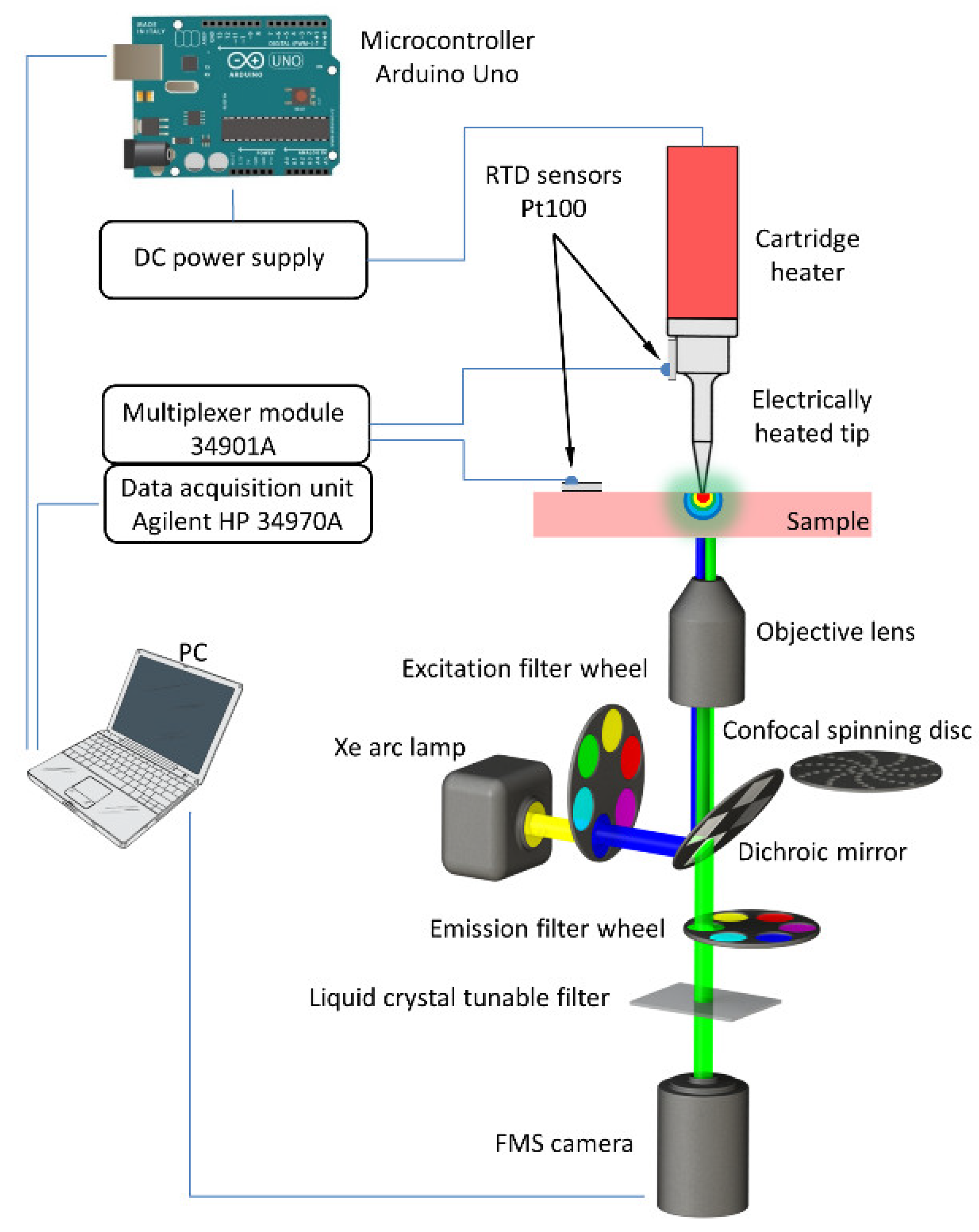
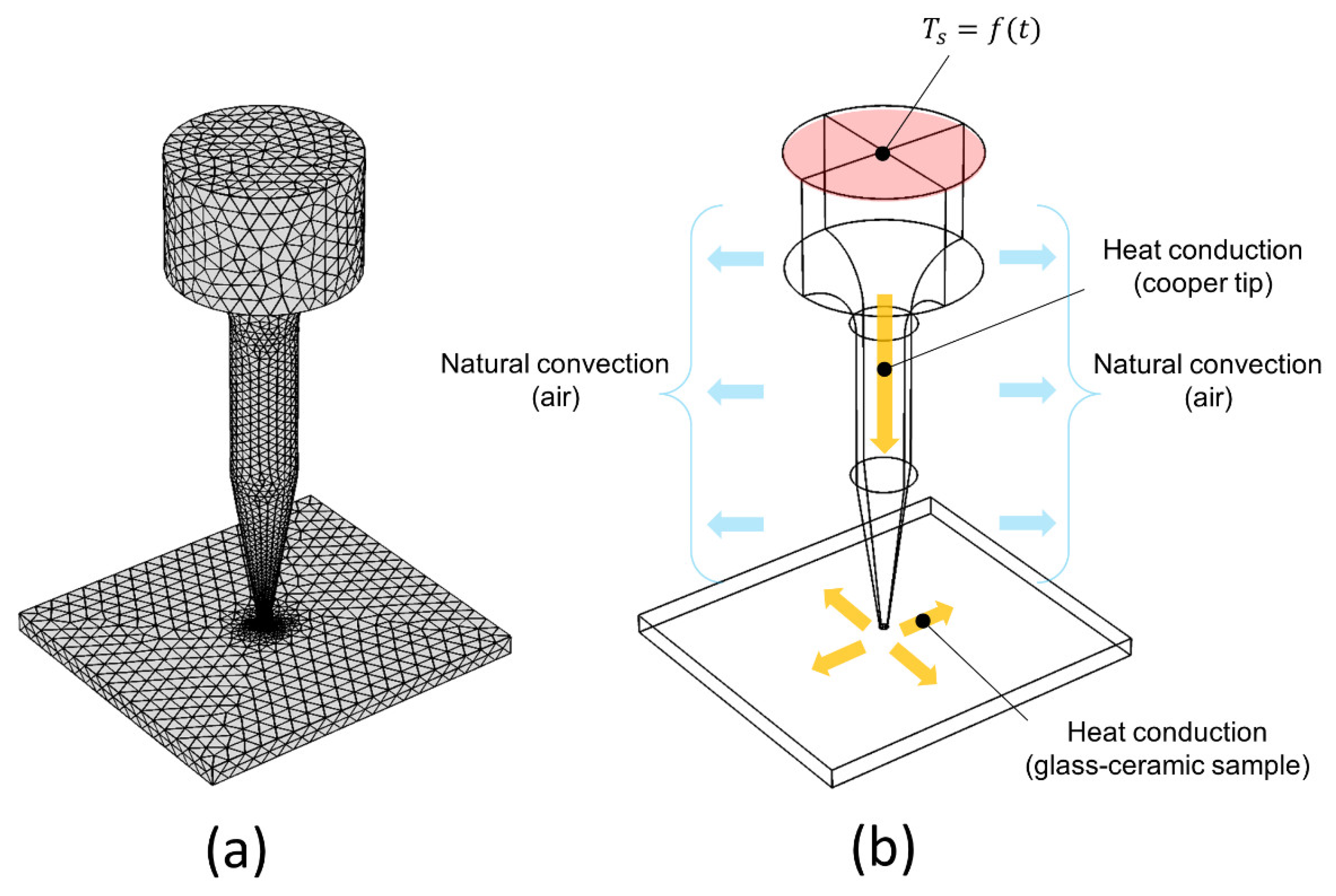

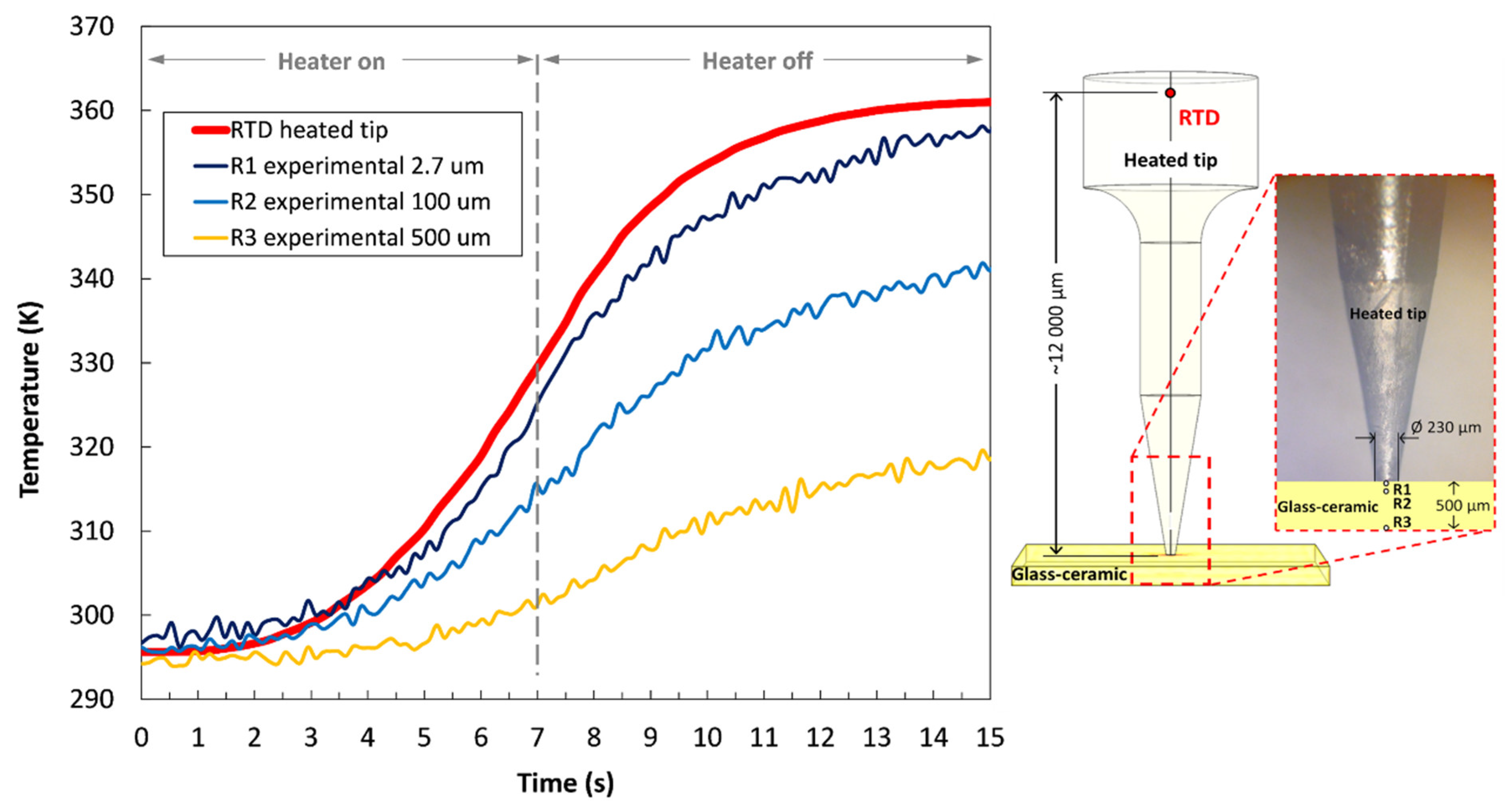
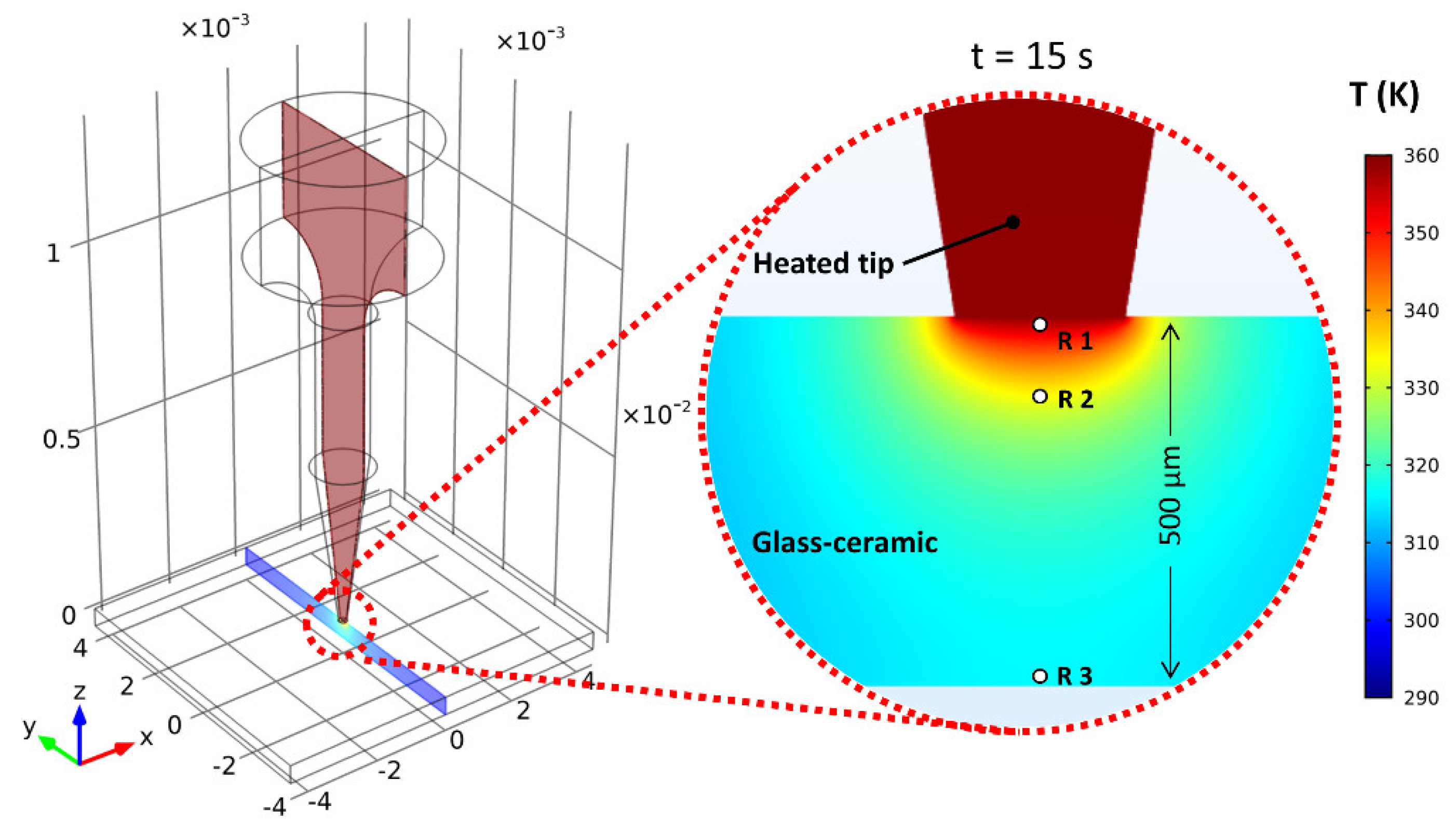

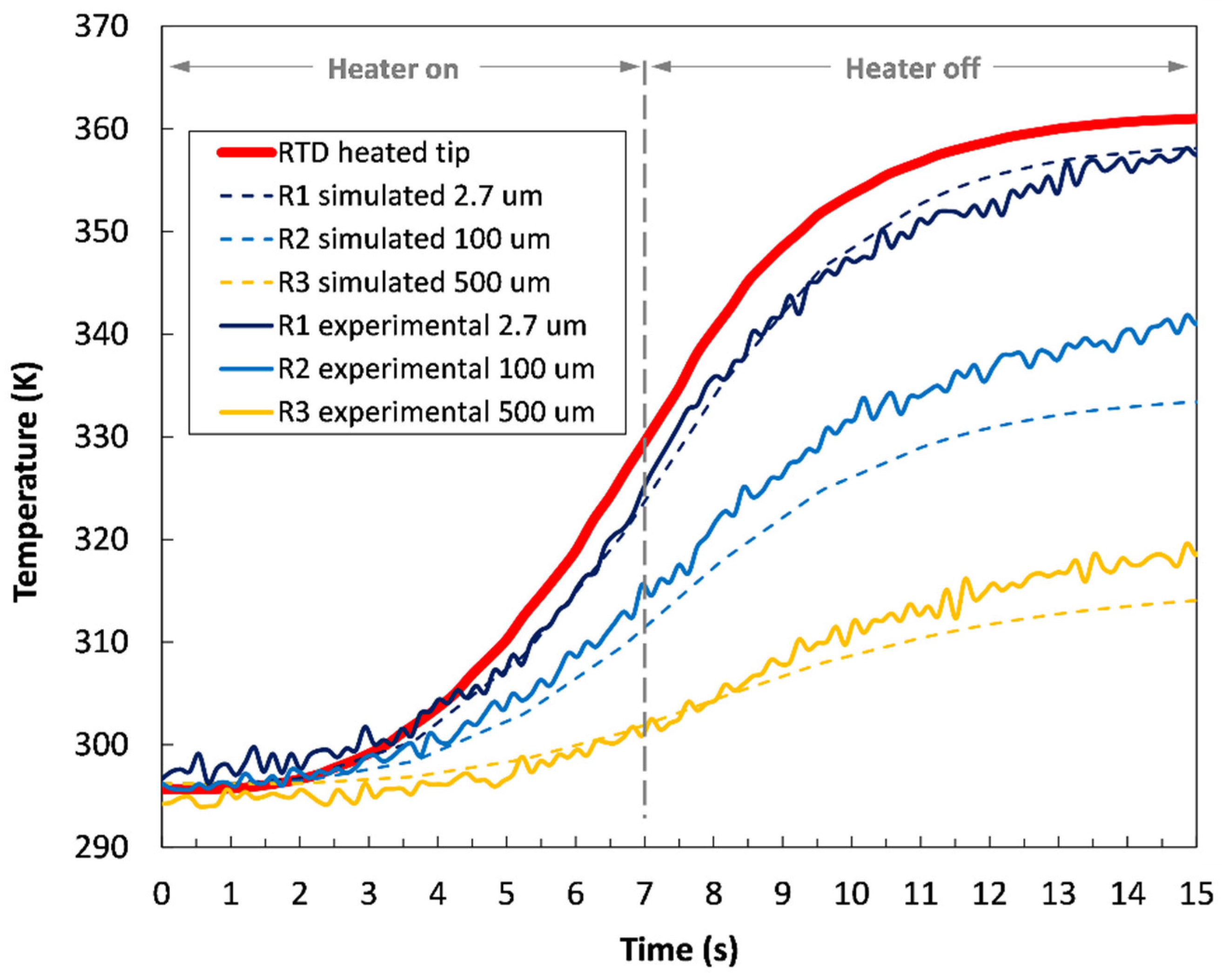
Publisher’s Note: MDPI stays neutral with regard to jurisdictional claims in published maps and institutional affiliations. |
© 2022 by the authors. Licensee MDPI, Basel, Switzerland. This article is an open access article distributed under the terms and conditions of the Creative Commons Attribution (CC BY) license (https://creativecommons.org/licenses/by/4.0/).
Share and Cite
Sedmak, I.; Podlipec, R.; Urbančič, I.; Štrancar, J.; Mortier, M.; Golobič, I. Spatially Resolved Temperature Distribution in a Rare-Earth-Doped Transparent Glass-Ceramic. Sensors 2022, 22, 1970. https://doi.org/10.3390/s22051970
Sedmak I, Podlipec R, Urbančič I, Štrancar J, Mortier M, Golobič I. Spatially Resolved Temperature Distribution in a Rare-Earth-Doped Transparent Glass-Ceramic. Sensors. 2022; 22(5):1970. https://doi.org/10.3390/s22051970
Chicago/Turabian StyleSedmak, Ivan, Rok Podlipec, Iztok Urbančič, Janez Štrancar, Michel Mortier, and Iztok Golobič. 2022. "Spatially Resolved Temperature Distribution in a Rare-Earth-Doped Transparent Glass-Ceramic" Sensors 22, no. 5: 1970. https://doi.org/10.3390/s22051970
APA StyleSedmak, I., Podlipec, R., Urbančič, I., Štrancar, J., Mortier, M., & Golobič, I. (2022). Spatially Resolved Temperature Distribution in a Rare-Earth-Doped Transparent Glass-Ceramic. Sensors, 22(5), 1970. https://doi.org/10.3390/s22051970








